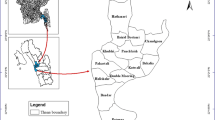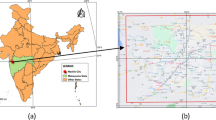Abstract
Large areas of cropland and natural vegetation have been replaced by impervious surfaces during the recent rapid urbanization in China, which has resulted in intensified urban heat island effects and modified local or regional warming trends. However, it is unclear how urban expansion contributes to local temperature change. In this study, we investigated the relationship between land surface temperature (LST) change and the increase of urban land signals. The megacity of Tianjin was chosen for the case study because it is representative of the urbanization process in northern China. A combined analysis of LST and urban land information was conducted based on an urban–rural transect derived from Landsat 8 Thermal Infrared Sensor (TIRS), Terra Moderate Resolution Imaging Spectrometer (MODIS), and QuickBird images. The results indicated that the density of urban land signals has intensified within a 1-km2 grid in the urban center with an impervious land fraction >60 %. However, the construction on urban land is quite different with low-/mid-rise buildings outnumbering high-rise buildings in the urban–rural transect. Based on a statistical moving window analysis, positive correlation (R 2 > 0.9) is found between LST and urban land signals. Surface temperature change (ΔLST) increases by 0.062 °C, which was probably caused by the 1 % increase of urbanized land (ΔIF) in this case region.







Similar content being viewed by others
References
Akbari H, Menon S, Rosenfeld A (2009) Global cooling: increasing world-wide urban albedos to offset CO2. Clim Chang 94:275–286. doi:10.1007/s10584-008-9515-9
Alchapar NL, Correa EN, Canton MA (2014) Classification of building materials used in the urban envelopes according to their capacity for mitigation of the urban heat island in semiarid zones. Energy Build 69:22–32. doi:10.1016/j.enbuild.2013.10.012
An XQ, Hou Q, Li N, Zhai SX (2013) Assessment of human exposure level to PM10 in China. Atmos Environ 70:376–386. doi:10.1016/j.atmosenv.2013.01.017
Arnfield AJ (2003) Two decades of urban climate research: a review of turbulence, exchanges of energy and water, and the urban heat island. Int J Climatol 23(1):1–26. doi:10.1002/joc.859
Bhang KJ, Park SS (2009) Evaluation of the surface temperature variation with surface settings on the urban heat island in Seoul, Korea, using Landsat-7 ETM+ and SPOT. IEEE Geosci Remote Sens Lett 6(4):708–712. doi:10.1109/Lgrs.2009.2023825
Bretz S, Akbari H, Rosenfeld A (1998) Practical issues for using solar-reflective materials to mitigate urban heat islands. Atmos Environ 32(1):95–101
Du Y, Xie ZQ, Zeng Y, Shi YF, Wu JG (2007) Impact of urban expansion on regional temperature change in the Yangtze River Delta. J Geogr Sci 17(4):387–398. doi:10.1007/s11442-007-0387-0
Feizizadeh B, Blaschke T (2013) Examining urban heat island relations to land use and air pollution: multiple endmember spectral mixture analysis for thermal remote sensing. IEEE J-Stars, 6(3), 1939–1404, doi: 10.1109/Jstars.2013.2263425
He YT, Jia GS, Hu YH, Zhou ZJ (2013) Detecting urban warming signals in climate records. Adv Atmos Sci 30(4):1143–1153. doi:10.1007/s00376-012-2135-3
Heusinkveld BG, Steeneveld GJ, van Hove LWA, Jacobs CMJ, Holtslag AAM (2014) Spatial variability of the Rotterdam urban heat island as influenced by urban land use. J Geophys Res Atmos 119(2):677–692. doi:10.1002/2012jd019399
Holderness T, Barr S, Dawson R, Hall J (2013) An evaluation of thermal earth observation for characterizing urban heatwave event dynamics using the urban heat island intensity metric. Int J Remote Sens 34(3):864–884. doi:10.1080/01431161.2012.714505
Hu YH, Jia GS (2009) Influence of land use change on urban heat island derived from multi-sensor data. Int J Climatol 30:1382–1395. doi:10.1002/joc.1984
Hu YC, Dong WJ, He Y (2010) Impact of land surface forcings on mean and extreme temperature in eastern China. J Geophys Res-Atmos 115, doi: 10.1029/2009jd013368
Jacobson MZ, Ten Hoeve JE (2012) Effects of urban surfaces and white roofs on global and regional climate. J Clim 25(3):1028–1044. doi:10.1175/JCLI-D-11-00032.1
Jin M, Shepherd JM (2005) Inclusion of urban landscape in a climate model—how can satellite data help? Bull Am Meteorol Soc 86:681–689. doi:10.1175/BAMS-86-5-681
Keramitsoglou I, Kiranoudis CT, Ceriola G, Weng QH, Rajasekar U (2011) Identification and analysis of urban surface temperature patterns in Greater Athens, Greece, using MODIS imagery. Remote Sens Environ 115:3080–3090. doi:10.1016/j.rse.2011.06.014
Kim KH, Jahan SA, Kabir E (2013) A review on human health perspective of air pollution with respect to allergies and asthma. Environ Int 59:41–52. doi:10.1016/j.envint.2013.05.007
Kondo A, Ueno M, Kaga A, Yamaguchi K (2001) The influence of urban canopy configuration on urban albedo. Bound-Layer Meteorol 100:225–242
Lazzarini M, Marpu PR, Ghedira H (2013) Temperature-land cover interactions: the inversion of urban heat island phenomenon in desert city areas. Remote Sens Environ 130:136–152. doi:10.1016/j.rse.2012.11.007
Lee T, Kim T (2013) Automatic building height extraction by volumetric shadow analysis of monoscopic imagery. Int J Remote Sens 34:5834–5850. doi:10.1080/01431161.2013.796434
Li JJ, Wang XR, Wangand XJ, Ma WC, Zhang H (2009) Remote sensing evaluation of urban heat island and its spatial pattern of the Shanghai metropolitan area, China. Ecol Complex 6(4):413–420. doi:10.1016/j.ecocom.2009.02.002
Nicholls N (2003) Continued anomalous warming in Australia. Geophys Res Lett 30(7)
Peng S, Piao S, Ciais P, Friedlingstein P, Ottle C, Breon FM, Nan H, Zhou L, Myneni RB (2012) Surface urban heat island across 419 global big cities. Environ Sci Technol 46(2):696–703. doi:10.1021/es2030438
Rosenfeld AH, Akbari H, Bretz SE et al (1995) Mitigation of urban heat islands: materials, utility programs, updates. Energy Build 22(3):255–265
Roy DP, Wulder MA, Loveland TR, Woodcock CE, Allen RG, Anderson MC, Helder D, Irons JR, Johnson DM, Kennedy R, Scambos TA, Schaaf CB, Schott JR, Sheng Y, Vermote EF, Belward AS, Bindschadler R, Cohen WB, Gao F, Hipple JD, Hostert P, Huntington J, Justice CO, Kilic A, Kovalskyy V, Lee ZP, Lymburner L, Masek JG, McCorkel J, Shuai Y, Trezza R, Vogelmann J, Wynne RH, Zhu Z (2014) Landsat-8: science and product vision for terrestrial global change research. Remote Sens Environ 145:154–172. doi:10.1016/j.rse.2014.02.001
Rozenstein O, Qin ZH, Derimian Y, Karnieli A (2014) Derivation of land surface temperature for Landsat-8 TIRS using a split window algorithm. Sensors 14:5768–5780. doi:10.3390/s140405768
Sailor DJ (1995) Simulated urban climate response to modifications in surface albedo and vegetative cover. J Appl Meteorol 34(7):1694–1704
Sarrat C, Lemonsu A, Masson V, Guedalia D (2006) Impact of urban heat island on regional atmospheric pollution. Atmos Environ 40(10):1743–1758. doi:10.1016/j.atmosenv.2005.11.037
Sobrino JA, Jiménez-Muñoz JC, Sòria G, Romaguera M, Guanter L, Moreno J, Plaza A, Martínez P (2008) Land surface emissivity retrieval from different VNIR and TIR sensors. IEEE T Geosci Remote 46(2):316–327. doi:10.1109/TGRS.2007.904834
Stathopoulou M, Cartalis C (2009) Downscaling AVHRR land surface temperatures for improved surface urban heat island intensity estimation. Remote Sens Environ 113(12):2592–2605. doi:10.1016/j.rse.2009.07.017
Su YF, Foody GM, Cheng KS (2012) Spatial non-stationarity in the relationships between land cover and surface temperature in an urban heat island and its impacts on thermally sensitive populations. Landsc Urban Plan 107(2):172–180. doi:10.1016/j.landurbplan.2012.05.016
Voogt JA, Oke TR (2003) Thermal remote sensing of urban climates. Remote Sens Environ 86(3):370–384. doi:10.1016/S0034-4257(03)00079-8
Wan ZM (2008) New refinements and validation of the MODIS land-surface temperature/emissivity products. Remote Sens Environ 112(1):59–74. doi:10.1016/j.rse.2006.06.026
Wang F, Qin ZH, Song CY, Tu LL, Karnieli A, Zhao SH (2015) An improved mono-window algorithm for land surface temperature retrieval from Landsat 8 thermal infrared sensor data. Remote Sens 7:4268–4289. doi:10.3390/rs70404268
Weng Q (2002) Land use change analysis in the Zhujiang Delta of China using satellite remote sensing, GIS and stochastic modeling. J Environ Manag 64(3):273–284
Weng QH (2009) Thermal infrared remote sensing for urban climate and environmental studies: methods, applications, and trends. ISPRS J Photogramm Remote Sens 64(4):335–344. doi:10.1016/j.isprsjprs.2009.03.007
Weng QH, Lu DS, Schubring J (2004) Estimation of land surface temperature-vegetation abundance relationship for urban heat island studies. Remote Sens Environ 89(4):467–483. doi:10.1016/j.rse.2003.11.005
Wu K, Yang XQ (2013) Urbanization and heterogeneous surface warming in eastern China. Chin Sci Bull 58:1363–1373
Yang X, Hou Y, Chen B (2011) Observed surface warming induced by urbanization in east China. J Geophys Res-Atmos 116
Yuan F, Bauer ME (2007) Comparison of impervious surface area and normalized difference vegetation index as indicators of surface urban heat island effects in Landsat imagery. Remote Sens Environ 106(3):375–386. doi:10.1016/j.rse.2006.09.003
Zhang Z, Wang X, Zhao X, Liu B, Yi L, Zuo L, Wen Q, Liu F, Xu J, Hu S (2014) A 2010 update of National Land Use/Cover Database of China at 1:100000 scale using medium spatial resolution satellite images. Remote Sens Environ 149:142–154. doi:10.1016/j.rse.2014.04.004
Zhou WQ, Qian YG, Li XM, Li WF, Han LJ (2014) Relationships between land cover and the surface urban heat island: seasonal variability and effects of spatial and thematic resolution of land cover data on predicting land surface temperatures. Landsc Ecol 29(1):153–167. doi:10.1007/s10980-013-9950-5
Acknowledgments
This work is supported by CAS Strategic Research Program (XDA05090203), National Natural Science Foundation of China (41405064, 41201044), “One-Three-Five” Strategic Planning by the Institute of Remote Sensing and Digital Earth, CAS (Y4SG0500CX), and China Meteorological Administration Special Public Welfare Research Fund (GYHY201406020). We thank the Institute of Remote Sensing and Digital Earth (RADI) for providing Landsat 8 (http://ids.ceode.ac.cn/query.html) and QuickBird images (http://cs.rsgs.ac.cn/cs_en/cshome.asp).
Author information
Authors and Affiliations
Corresponding author
Rights and permissions
About this article
Cite this article
Zhang, X., Hu, Y., Jia, G. et al. Land surface temperature shaped by urban fractions in megacity region. Theor Appl Climatol 127, 965–975 (2017). https://doi.org/10.1007/s00704-015-1683-8
Received:
Accepted:
Published:
Issue Date:
DOI: https://doi.org/10.1007/s00704-015-1683-8




